Peak of SO2 Emissions Embodied in International Trade: Patterns, Drivers and Implications
Abstract
:1. Introduction
2. Literature Review
3. Materials and Methods
3.1. Embodied Emissions in Trade
3.2. Structural Decomposition Analysis
3.3. Index Decomposition Analysis
3.4. Data Sources
4. Results
4.1. Patterns of Emissions Embodied in International Trade
4.2. Determinants of Changes in Emissions Embodied in International Trade
4.3. Production- and Consumption-Side Contributions of Regions
5. Discussion
6. Conclusions and Policy Implications
6.1. Conclusions
6.2. Policy Implications
Author Contributions
Funding
Institutional Review Board Statement
Informed Consent Statement
Data Availability Statement
Conflicts of Interest
References
- Xing, Z.; Wang, J.; Feng, K.; Hubacek, K. Decline of net SO2 emission intensity in China’s thermal power generation: Decomposition and attribution analysis. Sci. Total Environ. 2020, 719, 137367. [Google Scholar] [CrossRef]
- Xu, C.; Zhao, W.; Zhang, M.; Cheng, B. Pollution haven or halo? The role of the energy transition in the impact of FDI on SO2 emissions. Sci. Total Environ. 2020, 763, 143002. [Google Scholar] [CrossRef] [PubMed]
- Meng, J.; Yang, H.; Yi, K.; Liu, J.; Guan, D.; Liu, Z.; Mi, Z.; Coffman, D.M.; Wang, X.; Zhong, Q.; et al. The slowdown in global air-pollutant emission growth and driving factors. One Earth 2019, 1, 138–148. [Google Scholar] [CrossRef] [Green Version]
- Li, Y.L.; Chen, B.; Chen, G.Q. Carbon network embodied in international trade: Global structural evolution and its policy implications. Energy Policy 2020, 139, 111316. [Google Scholar] [CrossRef]
- Chen, W.; Qu, S.; Han, M.S. Environmental implications of changes in China’s inter-provincial trade structure. Resour. Conserv. Recycl. 2021, 167, 105419. [Google Scholar] [CrossRef]
- Cherniwchan, J.; Copeland, B.R.; Taylor, M.S. Trade and the environment: New methods, measurements, and results. Annu. Rev. Econ. 2017, 9, 59–85. [Google Scholar] [CrossRef] [Green Version]
- Mao, X.; He, C. A trade-related pollution trap for economies in transition? Evidence from China. J. Clean. Prod. 2018, 200, 781–790. [Google Scholar] [CrossRef]
- Wang, S.; He, Y.; Song, M. Global value chains, technological progress, and environmental pollution: Inequality towards developing countries. J. Environ. Manag. 2021, 277, 110999. [Google Scholar] [CrossRef]
- Liang, S.; Stylianou, K.S.; Jolliet, O.; Supekar, S.; Qu, S.; Skerlos, S.J.; Xu, M. Consumption-based human health impacts of primary PM2. 5: The hidden burden of international trade. J. Clean. Prod. 2017, 167, 133–139. [Google Scholar] [CrossRef]
- Greenaway, D.; Hine, R.; Milner, C. Vertical and horizontal intra-industry trade: A cross industry analysis for the United Kingdom. Econ. J. 1995, 105, 1505–1518. [Google Scholar] [CrossRef]
- Leitão, N.C.; Balogh, J.M. The impact of intra-industry trade on carbon dioxide emissions: The case of the European Union. Agric. Econ. 2020, 66, 203–214. [Google Scholar] [CrossRef]
- Leitão, N.C. Testing the role of trade on carbon dioxide emissions in Portugal. Economies 2021, 9, 22. [Google Scholar] [CrossRef]
- Leontief, W. Environmental repercussions and the economic structure: An input-output approach. Rev. Econ. Statis. 1970, 52, 262–271. [Google Scholar] [CrossRef]
- Wiedmann, T.; Lenzen, M. Environmental and social footprints of international trade. Nat. Geosci. 2018, 11, 314–321. [Google Scholar] [CrossRef]
- Jiang, L.; He, S.; Tian, X.; Zhang, B.; Zhou, H. Energy use embodied in international trade of 39 countries: Spatial transfer patterns and driving factors. Energy 2020, 195, 116988. [Google Scholar] [CrossRef]
- Wang, W.; Hu, Y. The measurement and influencing factors of carbon transfers embodied in inter-provincial trade in China. J. Clean. Prod. 2020, 270, 122460. [Google Scholar] [CrossRef]
- Chen, X.; Liu, W.; Zhang, J.; Li, Z. The change pattern and driving factors of embodied SO2 emissions in China’s inter-provincial trade. J. Clean. Prod. 2020, 276, 123324. [Google Scholar] [CrossRef]
- Li, Q.; Wu, S.; Lei, Y.; Li, S.; Li, L. Evolutionary path and driving forces of inter-industry transfer of CO2 emissions in China: Evidence from structural path and decomposition analysis. Sci. Total Environ. 2020, 765, 142773. [Google Scholar] [CrossRef]
- Zhen, W.; Li, J. The formation and transmission of upstream and downstream sectoral carbon emission responsibilities: Evidence from China. Sustain. Prod. Consump. 2021, 25, 563–576. [Google Scholar] [CrossRef]
- Feng, K.; Davis, S.J.; Sun, L.; Li, X.; Guan, D.; Liu, W.; Liu, Z.; Hubacek, K. Outsourcing CO2 within china. Proc. Natl. Acad. Sci. USA 2013, 110, 11654–11659. [Google Scholar] [CrossRef] [Green Version]
- Zheng, H.; Xu, L. Production and consumption-based primary PM2.5 emissions: Empirical analysis from China’s interprovincial trade. Resour. Conserv. Recycl. 2020, 155, 104661. [Google Scholar] [CrossRef]
- Zhang, Z.; Guan, D.; Wang, R.; Meng, J.; Zheng, H.; Zhu, K.; Du, H. Embodied carbon emissions in the supply chains of multinational enterprises. Nat. Clim. Chang. 2020, 10, 1096–1101. [Google Scholar] [CrossRef]
- Wu, X.; Li, C.; Guo, J.; Wu, X.; Meng, J.; Chen, G. Extended carbon footprint and emission transfer of world regions: With both primary and intermediate inputs into account. Sci. Total Environ. 2021, 775, 145578. [Google Scholar] [CrossRef]
- Arce, G.; López, L.A.; Guan, D. Carbon emissions embodied in international trade: The post-China era. Appl. Energy 2016, 184, 1063–1072. [Google Scholar] [CrossRef]
- Oita, A.; Malik, A.; Kanemoto, K.; Geschke, A.; Nishijima, S.; Lenzen, M. Substantial nitrogen pollution embedded in international trade. Nat. Geosci. 2016, 9, 111–115. [Google Scholar] [CrossRef]
- Liu, Q.; Long, Y.; Wang, C.; Wang, Z.; Wang, Q.; Guan, D. Drivers of provincial SO2 emissions in China–Based on multi-regional input-output analysis. J. Clean. Prod. 2019, 238, 117893. [Google Scholar] [CrossRef]
- Wang, Z.; Li, C.; Liu, Q.; Niu, B.; Peng, S.; Deng, L.; Kang, P.; Zhang, X. Pollution haven hypothesis of domestic trade in China: A perspective of SO2 emissions. Sci. Total Environ. 2019, 663, 198–205. [Google Scholar] [CrossRef]
- Yang, X.; Zhang, W.; Fan, J.; Li, J.; Meng, J. The temporal variation of SO2 emissions embodied in Chinese supply chains, 2002–2012. Environ. Pollut. 2018, 241, 172–181. [Google Scholar] [CrossRef]
- Liu, Z.; Song, P.; Mao, X. Accounting the effects of WTO accession on trade-embodied emissions: Evidence from China. J. Clean. Prod. 2016, 139, 1383–1390. [Google Scholar] [CrossRef]
- Chuai, X.; Lu, Q.; Li, J. Footprint of SO2 in China’s international trade and the interregional hotspot analysis. Appl. Geogr. 2020, 125, 102282. [Google Scholar] [CrossRef]
- Islam, M.; Kanemoto, K.; Managi, S. Impact of trade openness and sector trade on embodied greenhouse gases emissions and air pollutants. J. Ind. Ecol. 2016, 20, 494–505. [Google Scholar] [CrossRef] [Green Version]
- Zhong, Z.; Zhang, X.; Bao, Z. Spatial characteristics and driving factors of global energy-related sulfur oxides emissions transferring via international trade. J. Environ. Manag. 2019, 249, 109370. [Google Scholar] [CrossRef] [PubMed]
- Ang, B.W. Decomposition analysis for policymaking in energy: Which is the preferred method? Energy Policy 2004, 32, 1131–1139. [Google Scholar] [CrossRef]
- Su, B.; Ang, B.W.; Li, Y. Structural path and decomposition analysis of aggregate embodied energy and emission intensities. Energy Econ. 2019, 83, 345–360. [Google Scholar] [CrossRef]
- Li, D.; Huang, G.; Zhang, G.; Wang, J. Driving factors of total carbon emissions from the construction industry in Jiangsu Province, China. J. Clean. Prod. 2020, 276, 123179. [Google Scholar] [CrossRef]
- Li, W.; Xu, D.; Li, G.; Su, B. Structural path and decomposition analysis of aggregate embodied energy intensities in China, 2012–2017. J. Clean. Prod. 2020, 276, 124185. [Google Scholar] [CrossRef]
- Wang, X.; Huang, H.; Hong, J.; Ni, D.; He, R. A spatiotemporal investigation of energy-driven factors in China: A region-based structural decomposition analysis. Energy 2020, 207, 118249. [Google Scholar] [CrossRef]
- Kim, T.J.; Tromp, N. Carbon emissions embodied in China-Brazil trade: Trends and driving factors. J. Clean. Prod. 2021, 293, 126206. [Google Scholar] [CrossRef]
- Feng, K.; Davis, S.J.; Sun, L.; Hubacek, K. Drivers of the US CO2 emissions 1997–2013. Nat. Commun. 2015, 6, 1–8. [Google Scholar] [CrossRef] [Green Version]
- Zheng, J.; Mi, Z.; Coffman, D.M.; Shan, Y.; Guan, D.; Wang, S. The slowdown in China’s carbon emissions growth in the new phase of economic development. One Earth 2019, 1, 240–253. [Google Scholar] [CrossRef] [Green Version]
- Yuan, X.; Teng, Y.; Yuan, Q.; Liu, M.; Fan, X.; Wang, Q.; Ma, Q.; Hong, J.; Zuo, J. Economic transition and industrial sulfur dioxide emissions in the Chinese economy. Sci. Total Environ. 2020, 744, 140826. [Google Scholar] [CrossRef] [PubMed]
- Yang, X.; Wang, S.; Zhang, W.; Li, J.; Zou, Y. Impacts of energy consumption, energy structure, and treatment technology on SO2 emissions: A multi-scale LMDI decomposition analysis in China. Appl. Energy 2016, 184, 714–726. [Google Scholar] [CrossRef]
- Wang, Q.; Wang, Y.; Zhou, P.; Wei, H. Whole process decomposition of energy-related SO2 in Jiangsu Province, China. Appl. Energy 2017, 194, 679–687. [Google Scholar] [CrossRef]
- Hang, Y.; Wang, Q.; Wang, Y.; Su, B.; Zhou, D. Industrial SO2 emissions treatment in China: A temporal-spatial whole process decomposition analysis. J. Environ. Manag. 2019, 243, 419–434. [Google Scholar] [CrossRef]
- Zhang, P. End-of-pipe or process-integrated: Evidence from LMDI decomposition of China’s SO2 emission density reduction. Front. Environ. Sci. Eng. 2013, 7, 867–874. [Google Scholar] [CrossRef]
- Lin, J.; Pan, D.; Davis, S.J.; Zhang, Q.; He, K.; Wang, C.; Streets, D.G.; Wuebbles, D.J.; Guan, D. China’s international trade and air pollution in the United States. Proc. Natl. Acad. Sci. USA 2014, 111, 1736–1741. [Google Scholar] [CrossRef] [Green Version]
- Dietzenbacher, E.; Los, B. Structural decomposition techniques: Sense and sensitivity. Econ. Syst. Res. 1998, 10, 307–324. [Google Scholar] [CrossRef]
- Meng, J.; Mi, Z.; Guan, D.; Li, J.; Tao, S.; Li, Y.; Feng, K.; Liu, J.; Liu, Z.; Zhang, Q. The rise of South–South trade and its effect on global CO2 emissions. Nat. Commun. 2018, 9, 1–7. [Google Scholar] [CrossRef]
- Ang, B.W. LMDI decomposition approach: A guide for implementation. Energy Policy 2015, 86, 233–238. [Google Scholar] [CrossRef]
- Lenzen, M.; Moran, D.; Kanemoto, K.; Geschke, A. Building Eora: A global multi-region input–output database at high country and sector resolution. Econ. Syst. Res. 2013, 25, 20–49. [Google Scholar] [CrossRef]
- Peters, G.; Li, M.; Lenzen, M. The need to decelerate fast fashion in a hot climate-A global sustainability perspective on the garment industry. J. Clean. Prod. 2021, 295, 126390. [Google Scholar] [CrossRef]
- Yang, Y.; Qu, S.; Cai, B.; Liang, S.; Wang, Z.; Wang, J.; Xu, M. Mapping global carbon footprint in China. Nat. Commun. 2020, 11, 2237. [Google Scholar] [CrossRef] [PubMed]
- Lin, C.; Qi, J.; Liang, S.; Feng, C.; Wiedmann, T.O.; Liao, Y.; Yang, X.; Li, Y.; Mi, Z.; Yang, Z. Saving less in China facilitates global CO2 mitigation. Nat. Commun. 2020, 11, 1358. [Google Scholar] [CrossRef] [PubMed] [Green Version]
- Tian, J.; Liao, H.; Wang, C. Spatial-temporal variations of embodied carbon emission in global trade flows: 41 economies and 35 sectors. Nat. Hazards 2015, 78, 1–20. [Google Scholar] [CrossRef]
- Kander, A.; Jiborn, M.; Moran, D.D.; Wiedmann, T.O. National greenhouse-gas accounting for effective climate policy on international trade. Nat. Clim. Chang. 2015, 5, 431–435. [Google Scholar] [CrossRef]
- Zheng, X.; Wang, R.; Wood, R.; Wang, C.; Hertwich, E.G. High sensitivity of metal footprint to national GDP in part explained by capital formation. Nat. Geosci. 2018, 11, 269–273. [Google Scholar] [CrossRef]
- Duan, Y.; Ji, T.; Yu, T. Reassessing pollution haven effect in global value chains. J. Clean. Prod. 2021, 284, 124705. [Google Scholar] [CrossRef]
- Wang, X.; Zheng, H.; Wang, Z.; Shan, Y.; Meng, J.; Liang, X.; Feng, K.; Guan, D. Kazakhstan’s CO2 emissions in the post-Kyoto Protocol era: Production-and consumption-based analysis. J. Environ. Manag. 2019, 249, 109393. [Google Scholar] [CrossRef] [PubMed] [Green Version]
- Liu, J.; Murshed, M.; Chen, F.; Shahbaz, M.; Kirikkaleli, D.; Khan, Z. An empirical analysis of the household consumption-induced carbon emissions in China. Sustain. Prod. Consump. 2021, 26, 943–957. [Google Scholar] [CrossRef]
- Lin, B.; Wang, M. The role of socio-economic factors in China’s CO2 emissions from production activities. Sustain. Prod. Consump. 2021, 27, 217–227. [Google Scholar] [CrossRef]
- Jiang, X.; Guan, D. The global CO2 emissions growth after international crisis and the role of international trade. Energy Policy 2017, 109, 734–746. [Google Scholar] [CrossRef] [Green Version]
- The State Council of China (SCC). 11th Five Year Plan of National Environmental Protection. 2008. Available online: http://www.gov.cn/zhengce/content/2008-03/28/content_4877.htm (accessed on 28 March 2008). (In Chinese)
- The State Council of China (SCC). 12th Five Year Plan of National Environmental Protection. 2011. Available online: http://www.gov.cn/zwgk/2011-12/20/content_2024895.htm (accessed on 20 December 2011). (In Chinese)
- The State Council of China (SCC). 13th Five Year Plan of National Environmental Protection. 2016. Available online: http://www.gov.cn/zhengce/content/2016-12/05/content_5143290.htm (accessed on 5 December 2016). (In Chinese)
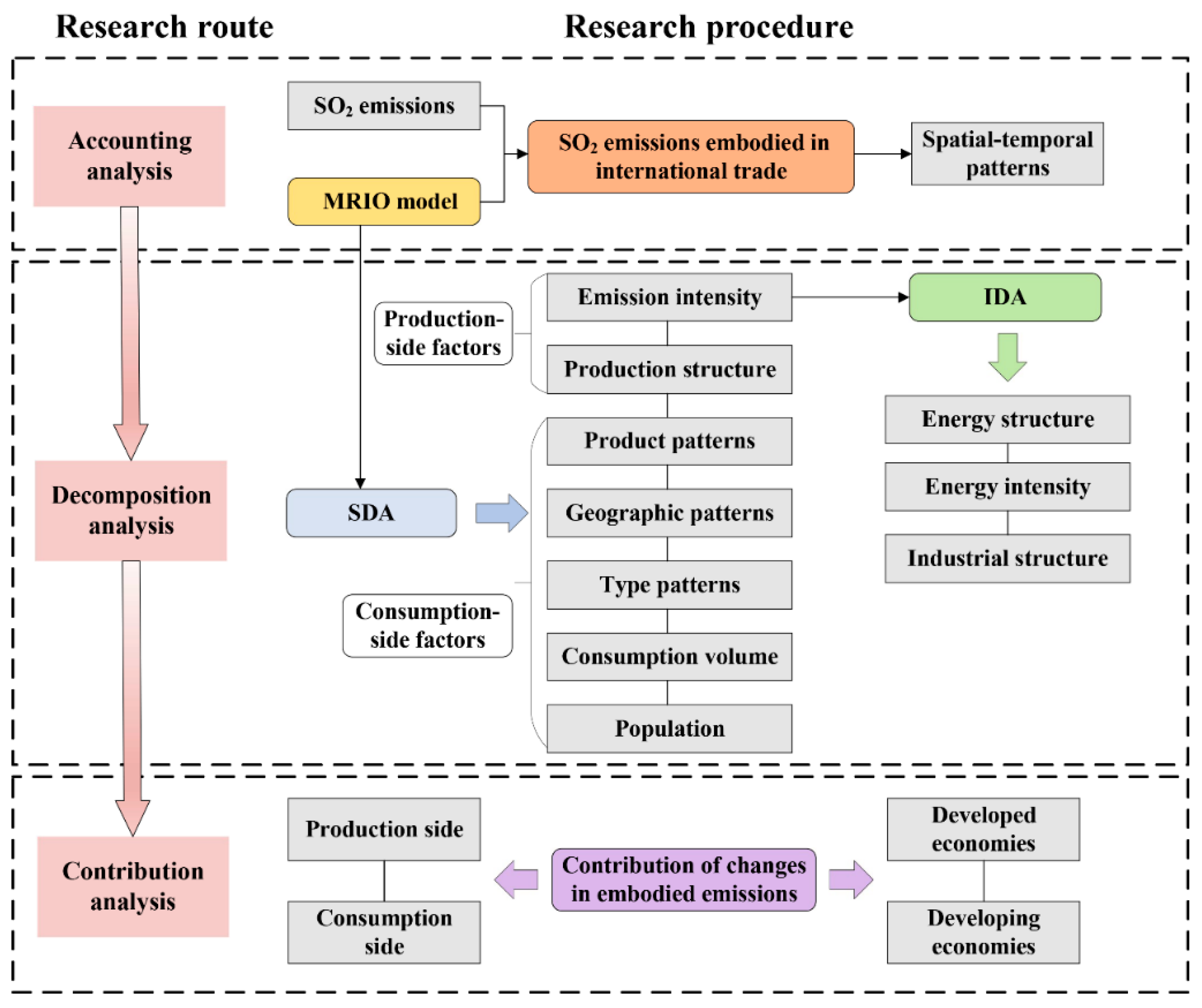
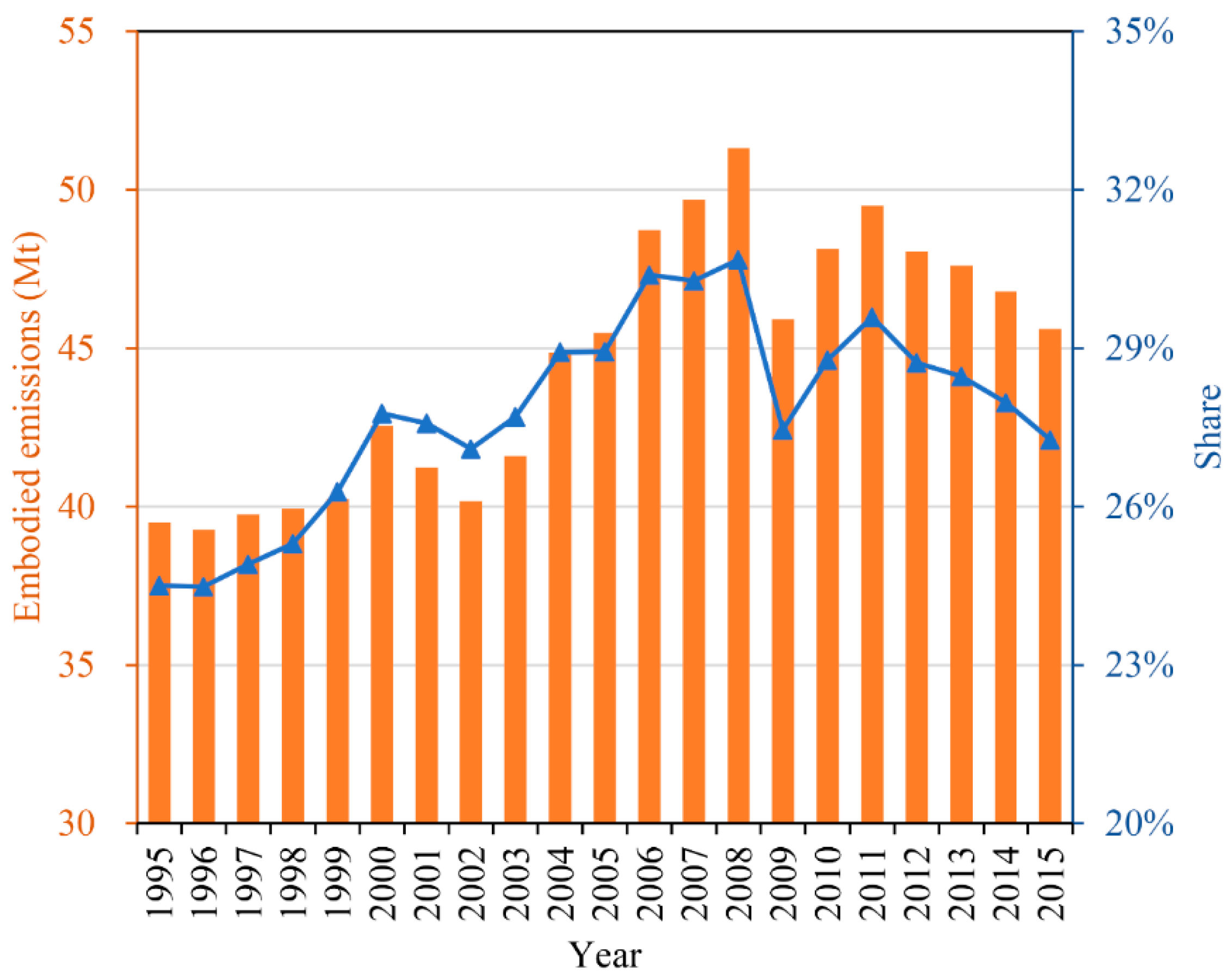
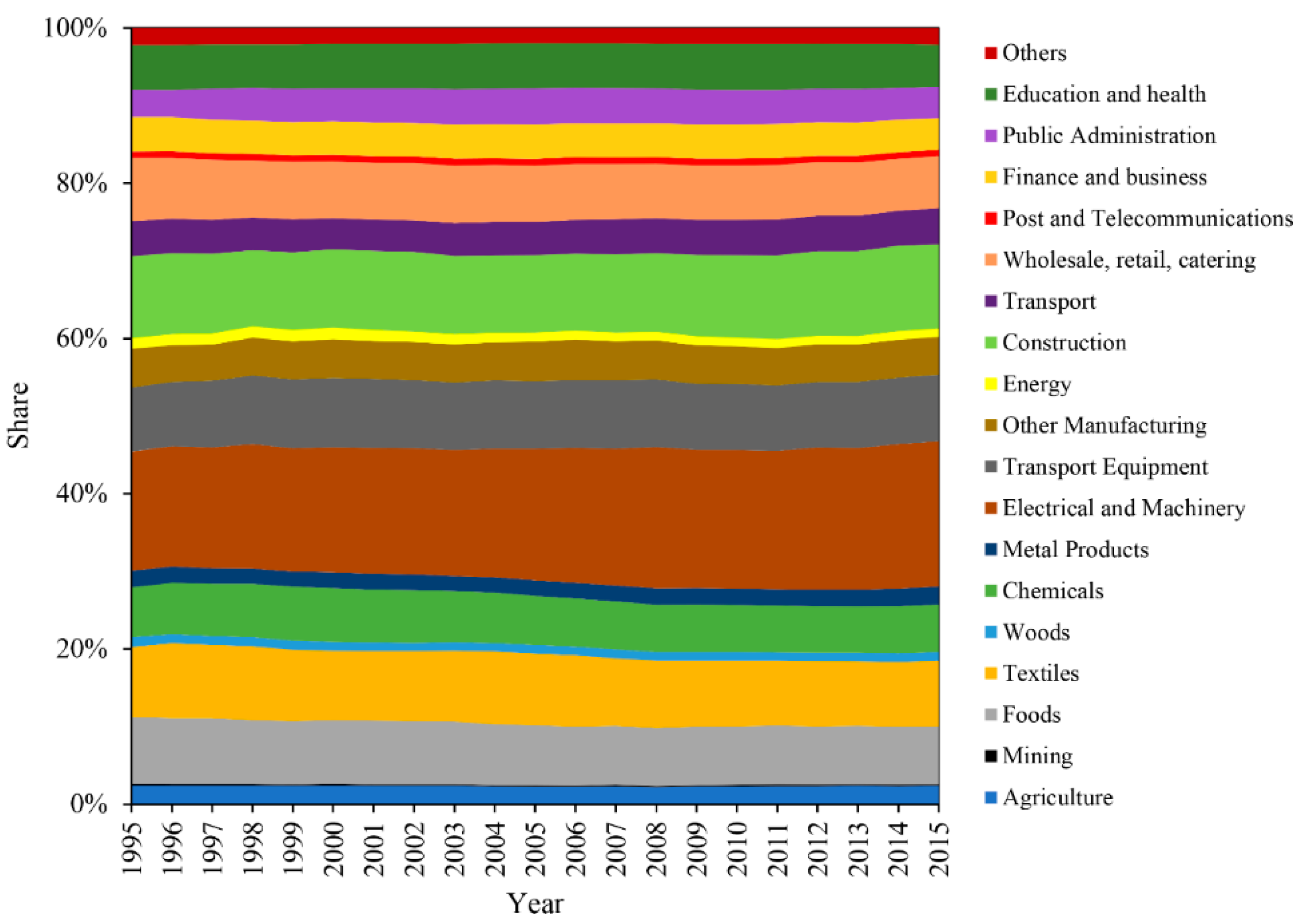
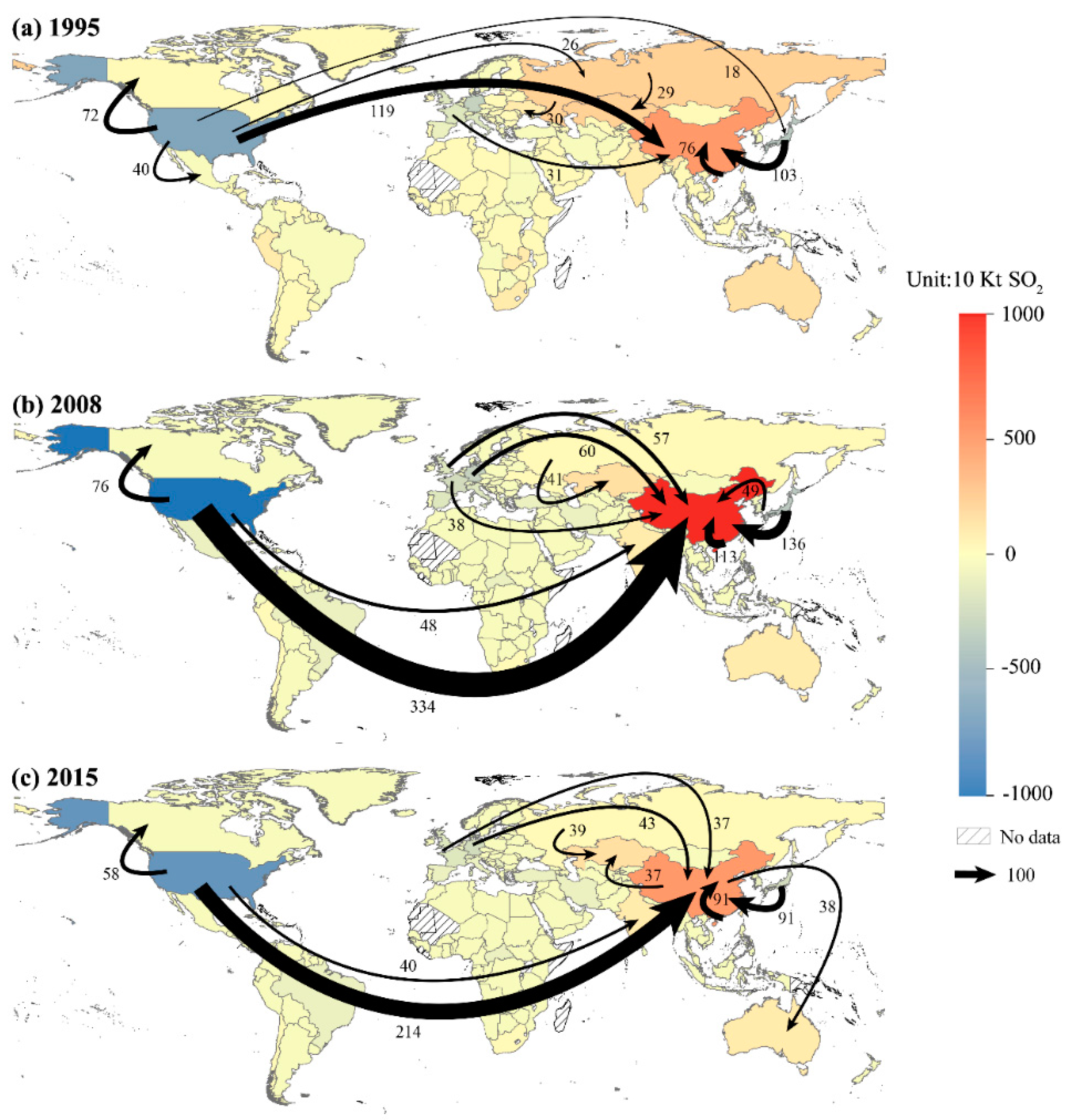
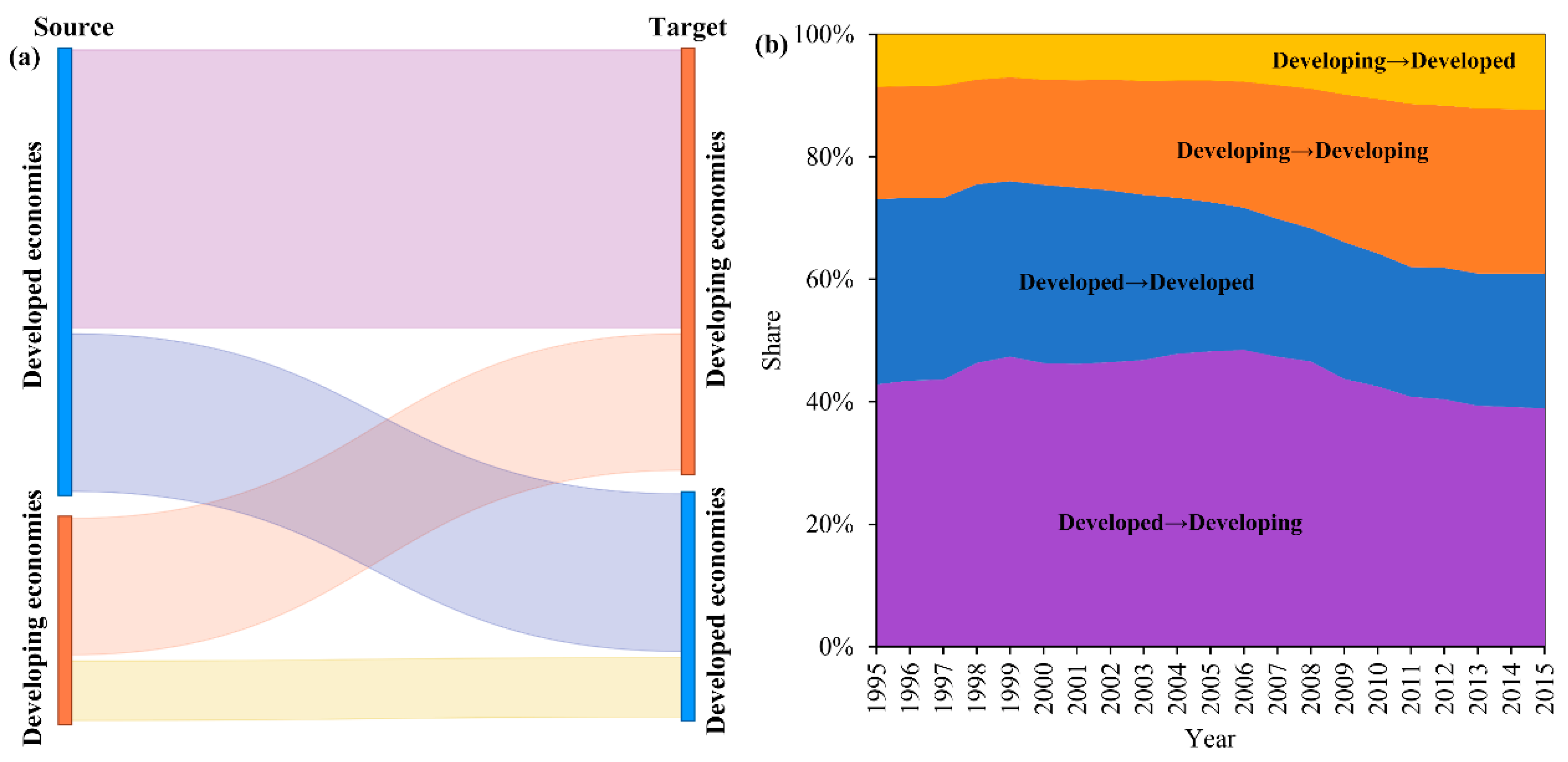
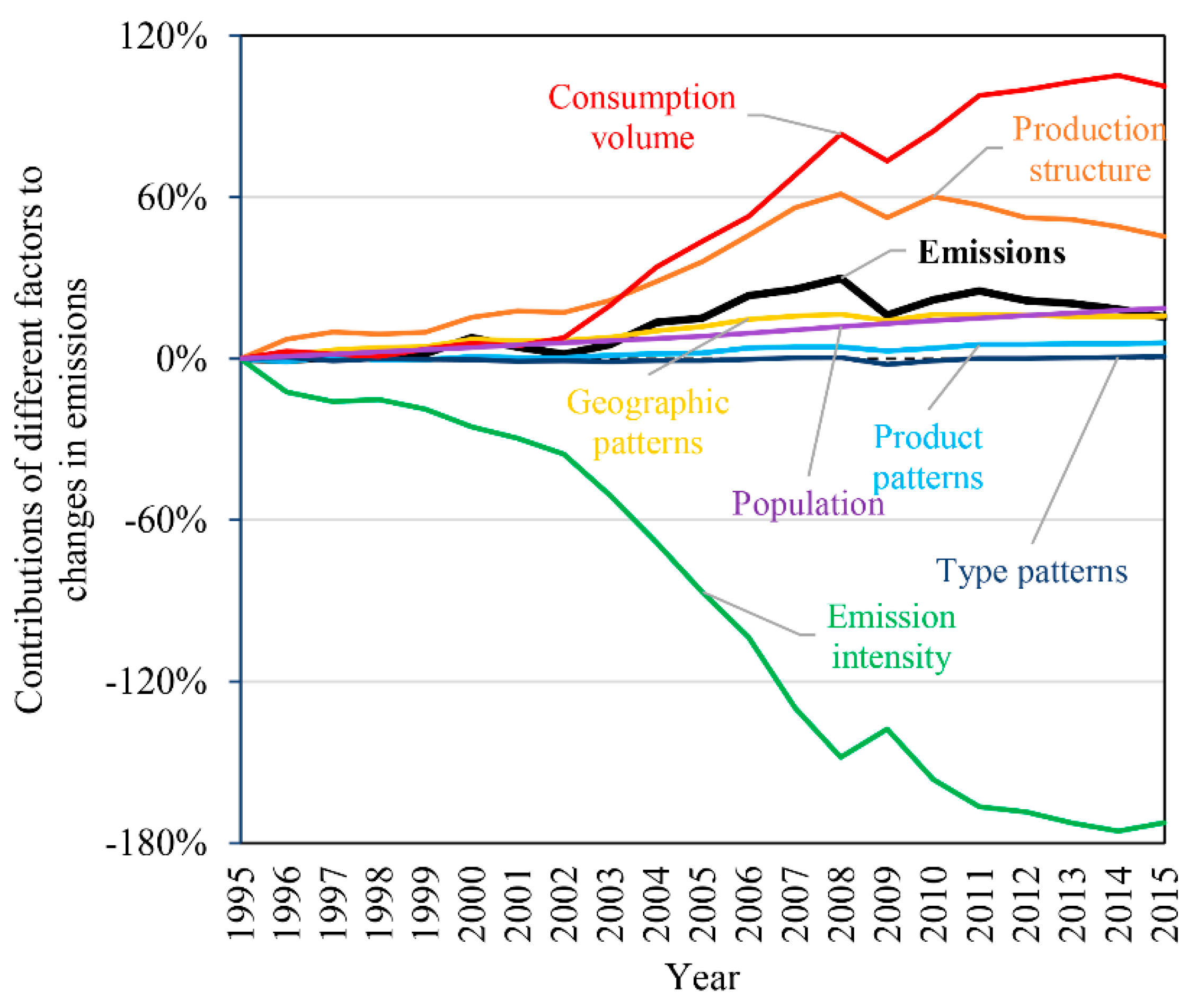

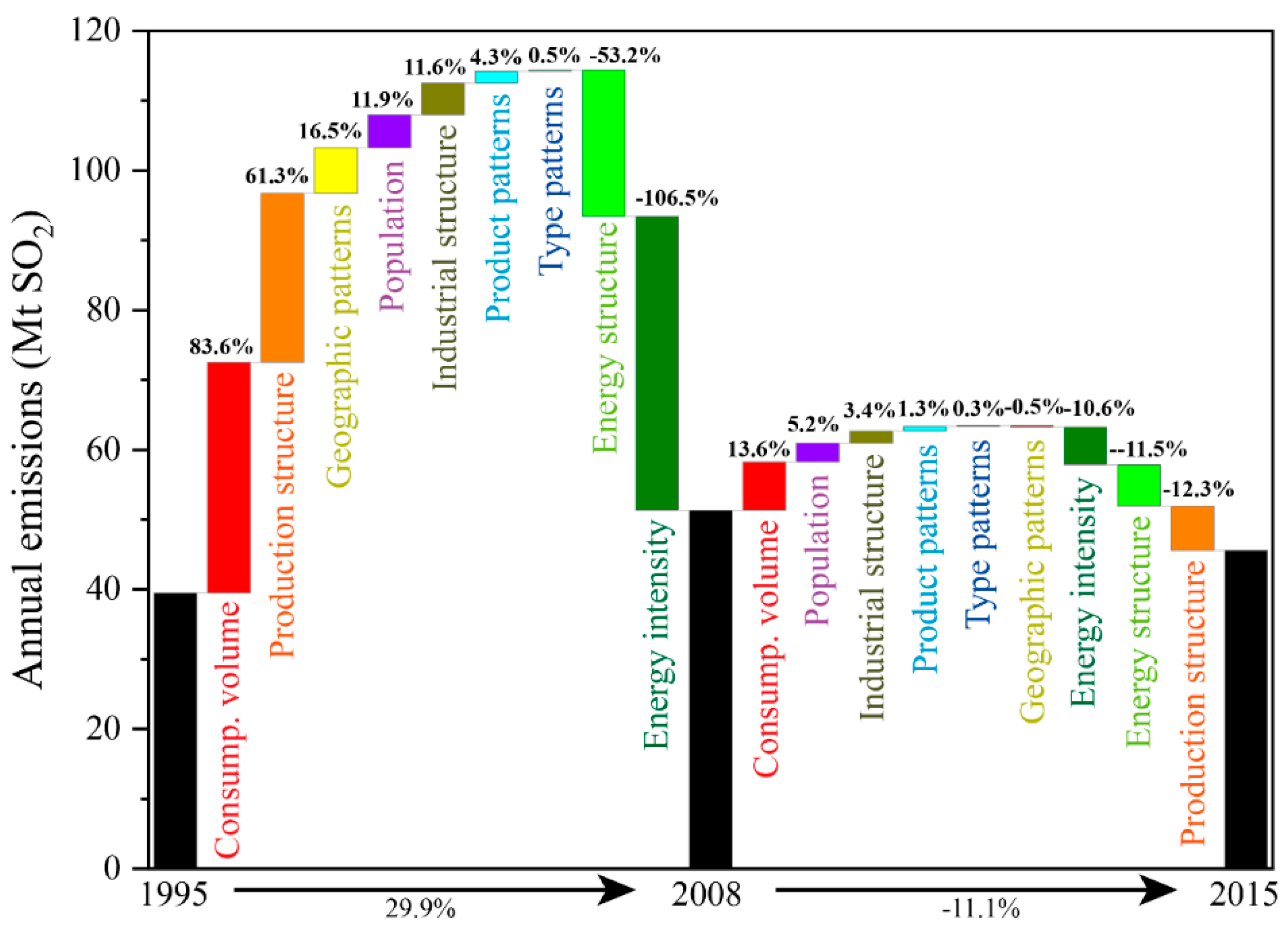
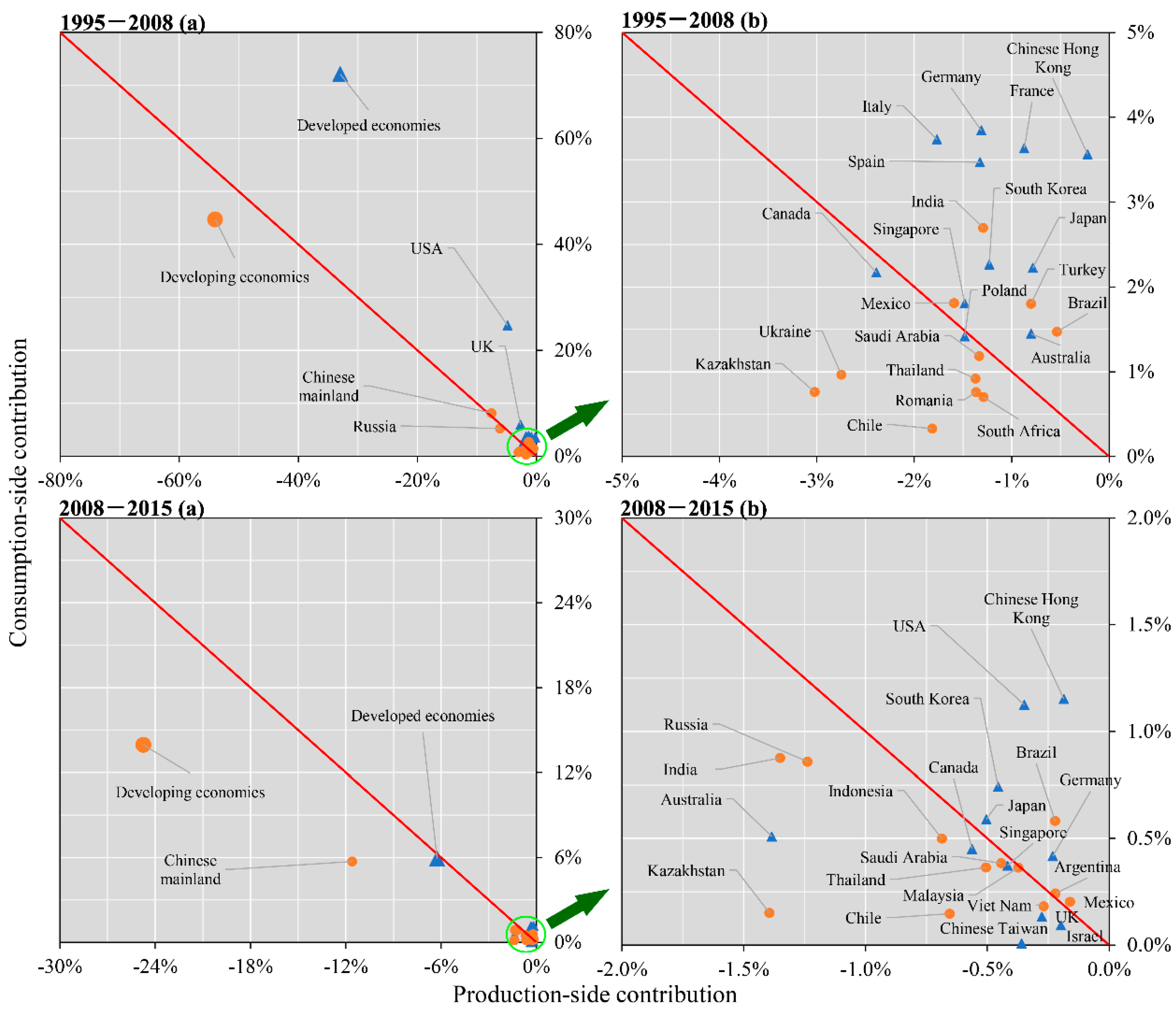
Publisher’s Note: MDPI stays neutral with regard to jurisdictional claims in published maps and institutional affiliations. |
© 2021 by the authors. Licensee MDPI, Basel, Switzerland. This article is an open access article distributed under the terms and conditions of the Creative Commons Attribution (CC BY) license (https://creativecommons.org/licenses/by/4.0/).
Share and Cite
Wang, B.; Huang, D.; Fan, C.; Xing, Z. Peak of SO2 Emissions Embodied in International Trade: Patterns, Drivers and Implications. Sustainability 2021, 13, 13351. https://doi.org/10.3390/su132313351
Wang B, Huang D, Fan C, Xing Z. Peak of SO2 Emissions Embodied in International Trade: Patterns, Drivers and Implications. Sustainability. 2021; 13(23):13351. https://doi.org/10.3390/su132313351
Chicago/Turabian StyleWang, Bin, Dechun Huang, Chuanhao Fan, and Zhencheng Xing. 2021. "Peak of SO2 Emissions Embodied in International Trade: Patterns, Drivers and Implications" Sustainability 13, no. 23: 13351. https://doi.org/10.3390/su132313351
APA StyleWang, B., Huang, D., Fan, C., & Xing, Z. (2021). Peak of SO2 Emissions Embodied in International Trade: Patterns, Drivers and Implications. Sustainability, 13(23), 13351. https://doi.org/10.3390/su132313351





